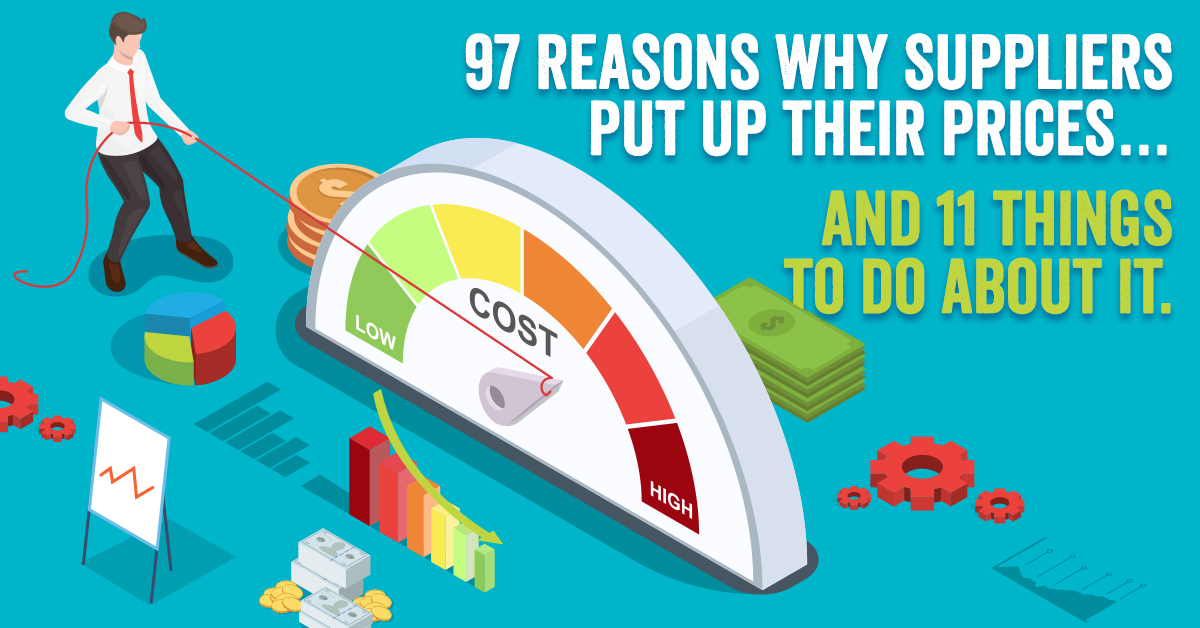Strategies for Reducing Supplier Costs and Avoiding Price Rises
If you haven’t already been hit by one of these 97 then chances are it’s right around the corner. So you need to do something about it. But what!
Check out our list below and highlight the ones that you think are the most likely to impact your business. Then keep scrolling and read about 11 Strategies you should consider to remedy or avoid those painful price rises.
97 Reasons to Increase Price
- You are too difficult/they don’t like you
- Change in market size
- Change in political climate
- Change in trade negotiations
- Changes in business strategy
- Changes in consumer preferences
- Changes in currency exchange rates
- Changes in distribution networks
- Changes in government subsidies
- Changes in import/export regulations
- Changes in industry standards
- Changes in labor laws
- Changes in production processes
- Changes in regulations and compliance requirements
- Changes in supplier management processes
- Changes in supplier policies
- Changes in supply chain structure
- Changes in tax laws
- Changes in trade policies
- Corporate social responsibility initiatives
- Cost of raw materials
- Currency fluctuations
- Economic recession
- Economic sanctions
- Environmental and sustainability regulations
- Globalization
- Government interventions
- Higher demand for products
- Higher labour costs
- Increase in compliance requirements
- Increase in customs clearance costs
- Increase in cyber-security costs
- Increase in demand for natural resources
- Increase in demand from emerging markets
- Increase in energy costs
- Increase in environmental compliance costs
- Increase in health and safety compliance costs
- Increase in import and export fees
- Increase in import/export duties
- Increase in intellectual property costs
- Increase in interest rates
- Increase in inventory carrying costs
- Increase in legal and regulatory costs
- Increase in logistics costs
- Increase in marketing and advertising costs
- Increase in marketing costs
- Increase in packaging and labelling costs
- Increase in product complexity
- Increase in product liability insurance
- Increase in production capacity
- Increase in production costs
- Increase in quality standards
- Increase in research and development costs
- Increase in risk and uncertainty
- Increase in social compliance costs
- Increase in staff turnover
- Increase in supplier audits and inspections
- Increase in supplier capacity requirements
- Increase in supplier certification and qualification
- Increase in supplier collaboration and partnership
- Increase in supplier diversity and inclusion requirements
- Increase in supplier engagement and communication requirements
- Increase in supplier environmental responsibility requirements
- Increase in supplier ethical responsibility requirements
- Increase in supplier innovation requirements
- Increase in supplier monitoring and reporting.
- Increase in supplier performance metrics and KPIs
- Increase in supplier performance reviews and feedback
- Increase in supplier quality requirements
- Increase in supplier risk management requirements
- Increase in supplier social responsibility requirements
- Increase in supplier sustainability requirements
- Increase in supplier training and development
- Increase in supplier transparency requirements
- Increase in supply chain complexity
- Increase in transportation costs
- Increase in transportation costs
- Increased insurance costs
- Increases in demand for commodities
- Inflation
- Intellectual property costs
- Investment in new technology
- Limited availability of certain resources
- Limited availability of skilled labour
- Market competition
- Market demand and supply
- Natural disasters
- Product innovation
- Rise in energy costs
- Rise in wages
- Seasonal factors
- Short-term market volatility
- Supply chain disruptions
- Taxes and tariffs
- Technological advancements
- Trade restrictions
- Unforeseen events
11 Strategies for Reducing Supplier Costs or Avoiding Price Rises.
Establish long-term partnerships
Develop long-term relationships with suppliers based on trust and mutual respect. This can lead to better collaboration and a willingness to negotiate prices and cost reductions.
Provide forecasted demand
Provide suppliers with accurate forecasts of demand, so they can plan production and avoid unnecessary inventory buildup, reducing costs.
Streamline processes
Work with suppliers to streamline processes and reduce waste. This can lead to cost savings and increased efficiency for both parties.
Implement joint cost-saving initiatives
Collaborate with suppliers to identify cost-saving opportunities, such as joint procurement, bulk purchasing, and shared logistics.
Implement supplier development programs
Invest in supplier development programs to help suppliers improve their processes, quality, and efficiency. This can lead to cost savings and increased competitiveness.
Negotiate pricing
Negotiate prices with suppliers based on volume, timing, and quality. This can help reduce costs and avoid price rises.
Offer early payment discounts
Offer early payment discounts to suppliers, encouraging them to reduce prices in exchange for prompt payment.
Leverage technology
Leverage technology to improve communication and collaboration with suppliers, streamline processes, and reduce costs.
Optimize inventory management
Optimize inventory management to minimize excess inventory and reduce costs associated with storage and logistics.
Monitor supplier performance
Monitor supplier performance to identify areas for improvement and ensure that they are meeting quality and delivery standards.
Evaluate alternative suppliers
Evaluate alternative suppliers to increase competition and negotiate better pricing and terms with current suppliers.
Get help with Implementing These Strategies
Did I say 11 Strategies? Well, here is a bonus 12th for you. Don’t try this on your own if you don’t have the internal experience or capability. Get Help. Comprara are leaders in procurement consulting, procurement data analytics and procurement capability working with many of Australia’s major companies, Governments, and non-profits. Our expertise and tools can help you gain more ground through enhancements in your procurement processes, data analysis and people skills. Please reach out for assistance with any of these 11 strategies or more.



